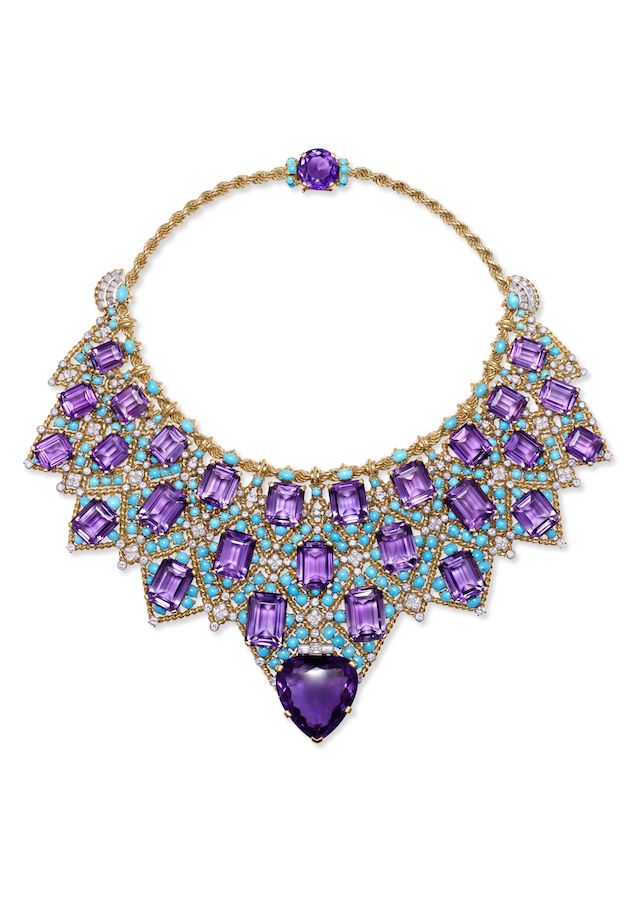PARIS: Having already explored its links with Japan and ancient Egypt, the French luxury goods brand Cartier is now exploring the profound influence that Islamic art has had on the company’s history.
To do so, Cartier turned to the Louvre — home to both the Museum of Decorative Arts and the Department of Islamic Arts. The former hosts the largest collection of jewelry in France, while the latter contains a priceless and historic collection of artworks from the Islamic world.
The result is “Cartier and Islamic Art: In Search of Modernity,” an exhibition that runs in Paris from October 21 to February 20, and will then travel to the Dallas Museum of Art (DMA) in Texas.

17th Century Court Belt from Iran or India - silk with silver thread - from the Louvre. (Supplied)
Arab News spoke to Evelyne Possémé, chief curator of ancient and modern jewelry at the Musée des Arts Décoratifs, and Judith Henon-Raynaud, curator and deputy director of the Department of Islamic Arts at the Louvre — two of the four curators of the exhibition. (The other two curators are Thomas W. Lentz, curator of Islamic and medieval art at the DMA, and Sarah Schleuning, the DMA’s interim chief curator and The Margot B. Perot senior curator of decorative arts and design.)
The exhibition, based on research that began in 2018 at the Louvre into Louis Cartier’s personal collection of Islamic art, consists of more than 500 pieces, including jewelry and other objects from Cartier, along with drawings, books, photos and archival documents tracing the brand’s interest in Islamic arts.
“The museum had acquired two Indian ivory pencil boxes from the early seventeenth century, which were part of this hitherto unknown collection,” Possémé told Arab News.

Cladding panel from Iran in late 14th - 15th century. (Supplied)
The exhibition is organized as a themed chronological tour divided into two parts, the first of which explores the origins of Cartier’s interest in Islamic art and architecture through the cultural backdrop of Paris at the beginning of the 20th century and reviews the creative context, as designers and studios searched for sources of inspiration. It includes pieces from Cartier’s library, Louis Cartier’s personal Islamic art collection, and Indian and Iranian jewelry.
The second part of the exhibition is dedicated to pieces inspired by Islamic art, from the start of the 20th century to the present day, and draws heavily on drawings, jewelry and objects from collections belonging to the Musée des Arts Décoratifs and the Musée du Louvre, which were part of the first exhibitions devoted to the arts of Islam.
The gallery exhibits some major pieces inspired by Islamic art and as well as animations detailing the composition of the jewels and their patterns.

Tiara, Cartier London, 1936. Platinum, diamonds, turquoise. (Supplied)
From the outset, visitors find themselves immersed in these shapes and motifs, with three of Cartier’s iconic creations set against masterpieces of Islamic art.
“The discovery of Islamic art at the beginning of the twentieth century had a significant impact on Cartier’s creators,” Henon-Raynaud explained. “Although famed for its garland-style jewelry, from 1904 onwards Cartier began developing pieces inspired by the geometric patterns of Islamic art found in books about ornamentation and architecture.”
The two curators cite enameled brick decorations originating from Central Asia and stepped merlons in the Art Deco style (a reference to the International Exhibition of Modern Decorative and Industrial Arts in Paris in 1925) as early influences on Cartier’s shift in its design philosophy.

Bib necklace 1947 - twisted 18- and 20-karat gold with diamonds and amethysts. (Supplied)
“This source of inspiration is perceptible throughout the twentieth century in the creations of the house,” explained Possémé. “They were sometimes easily identifiable, at other times broken down and redesigned to make their source untraceable.”
The House of Cartier, founded in 1847 by Louis-François Cartier, initially specialized in selling jewels and artworks. It was only when Louis-François’ son Alfred took over the management of the company in 1874 — supported by his eldest son Louis in 1898 — that the house began to design its own jewelry, while continuing its activity of reselling antique pieces.
At the beginning of the twentieth century, Paris was a hub for trade in Islamic art. Thanks to major exhibitions organized at the Musée des Arts Décoratifs in Paris in 1903 and then in Munich in 1910, Louis Cartier discovered these new shapes that gradually permeated French society.

1924 head ornament - Cartier New York - Platinum - white and pink gold - diamonds and feathers. (Supplied)
Jacques Cartier, an enthusiastic traveler, visited India in 1911 to meet various Maharajas. The gemstone trade was in full swing by that time, and allowed Cartier to build a strong relationship with the Indian princes, so he collected many antique and contemporary jewelry items, which he would either resell unchanged, use as inspiration, or dismantle for incorporation into new designs.
“The influence of Islamic art is also clear in (Cartier’s) use of bold color ranges — lapis lazuli blue, emerald green and turquoise, for example — at a time when jewels tended to be created using diamonds in monochrome settings,” Henon-Raynaud said. “Finally, shapes and construction of jewelry from Persia and India gave rise to technical innovations such platinum mountings, in order to gain flexibility.”












